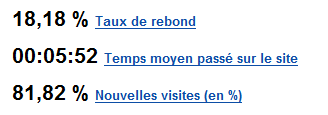How to improve rebound speed
This is the percentage of visitors who leave the site after viewing one page, so do not want to view another. This setting is important for knowing what visitors think of your site.
First, you need to draw the difference between the rebound speed and the exit speed. The rebound ratio is the number of visitors who leave the site without looking at the second page.
Page Exit Ratio is the percentage of visitors who leave the site after viewing this page. Output speed is usually more dependent on quality than rebound speed.
Example
These are statistics provided by the site (actually the Anaa de scriptol.com catalog): 18% rebound rate and an average reading time of 6 minutes.

The 18% rebound percentage can be called satisfactory on the site or each page provides complete information: visitors, having received information, nevertheless want to read other pages.
We interpret the bounce rate by associating it with time spent: if the bounce is small, but so is the time, it will mean that visitors don't find what they're looking for and quickly move from one page to another. The longer the time spent and the more positive the low rebound rate makes sense.
The percentage of new visits is related to the percentage of visits to the engines: They bring new visitors, while reference sites and bookmarks return the same. This is also due to the expansion of visits. Therefore, its interpretation depends on external factors.
This factor complements the rebound coefficient, it is better to be low, if the rebound coefficient is high, this suggests that visitors have found up-to-date information, even if they read only one page .
Low rebound rate factors
To reduce the rate and, therefore, preserve visitors, the following factors are important:
- Design.
A pleasant presentation encourages you to visit the site. See article as a quality site. - Download speed.
On a site whose pages are endlessly loaded, it is not recommended to pursue or return. The use of CMS must be associated with quality hosting in order to have reactive databases. - Interest.
When the text is interesting, in good French and without spelling errors, I want to see what else the author wrote. - Text size.
Short articles encourage reading of other pages (but full-text ones are more likely to get backlinks and therefore new visits). This option is especially useful for reporting statistics. - External links and advertising.
If a visitor clicks on a link or ad, they are lost to the site (tentatively). So pages full of 1 cent ads should be banned. See the Adsense tutorial on this topic.
Links to external sites are indispensable and help position search engines in results, simply avoiding irrelevant ones. - Customize Keywords.
The rebound factor is the fact that the page you come to does not match what you are looking for in the search engine. Therefore, you must select the keywords that best fit the content. - Dictionaries.
Such sites certainly have a very high rebound rate, although the content is quite relevant for search. It, however, can be reduced by internal connections.
High rebound ratio fines the court
?If Google knows a site's bounce percentage, will it contribute to its score or fine it based on whether the percentage is low or strong? Is he going to assess that a site whose few pages are visited is useless and punish it?
According to the Google Analytics service, which is offered by Google, a high indicator indicates a lack of relevance and, therefore, is negative. This is the point of view of the search engine.
If you have a high rate, above 65%, then it would be better (this is a theory) not to use Google Analytics, which directly provides these numbers to Google!
However, you can also find out about the rebound speed from clicks in the query results. We can't hide it from Google, we can only try to improve it!
But does Google use those numbers?
Yeah, maybe...
An article published on an American site dedicated to SEO, based on a study of the results, gives the following answer: yes, Google uses a rebound ratio to fine sites and, in addition, uses Google Analytics data.
But if you study the article in more detail, then there is a doubt about its statistical value. 100 users on the site do not mean anything without activity, this may be the only arrival of visitors to the experiment that changes the results. By the way, the author of this article was associated with a statistics provider competing with Analytics!
A counter example is when the Anaa folder, on .fr, has a very low rebound rate and after installing Google Analytics, this did not affect Google's results in any way.
So it has no connection to Analytics, as Google confirms.
Google's response
One answer is given by Matt Cutts: this is not a factor that fines the page in the general algorithm. But this is information that dates back and since then the algorithm has been able to change.
In addition, if Internet users return to the result page after accessing your page to find other sites, this is a negative signal (for at least query keywords). Visitors are always better off staying on your site.